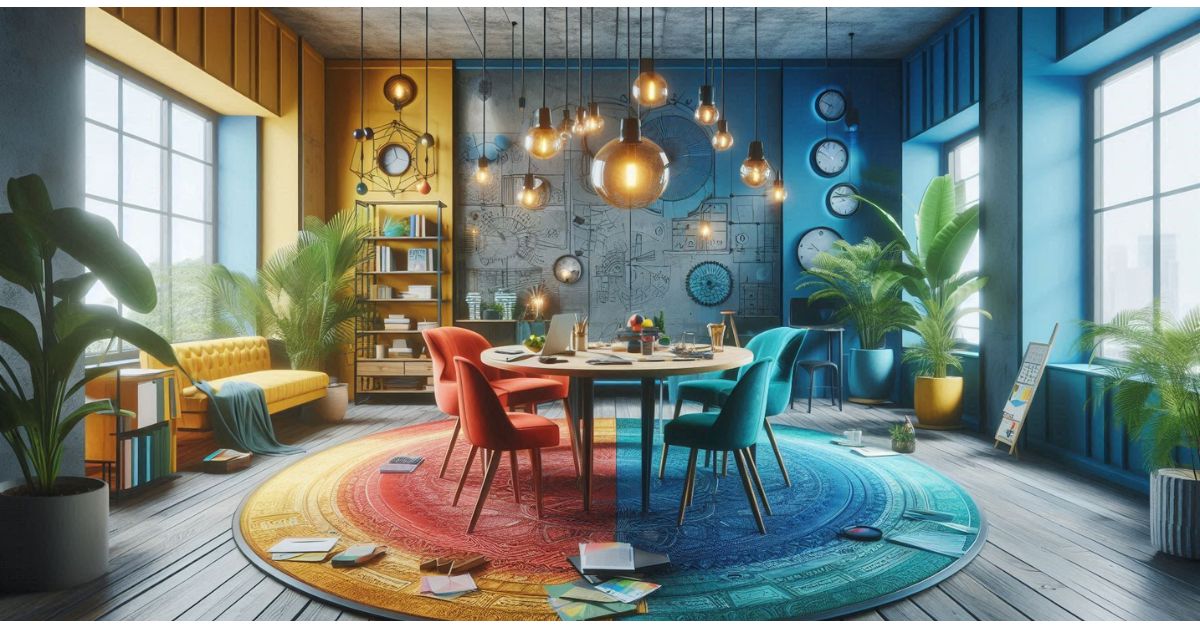Revitalizing Your Space: The Impact of Home Decor on Wellbeing
It’s fascinating how a room’s decor influences our thoughts and feelings. Research has demonstrated that certain design elements, such as the room’s color scheme or spatial layout, can significantly affect our psychological state. Colors, in particular, have been found to evoke strong emotional responses — blues and greens usually incite a sense of calm, while yellows and reds can stimulate energy and appetite. The strategic arrangement of furniture can encourage social interaction or, conversely, create private, tranquil corners for individual reflection.
The psychological implications of our surroundings are an essential consideration, especially when selecting cheap home decor pieces that will define our living spaces. For those on a budget, wall art or decorative accents can act as mood enhancers without necessitating a significant expense. A thoughtful selection of these items can promote a serene and inviting home atmosphere, which is particularly beneficial after a stressful day. It’s about crafting an environment that supports and uplifts rather than merely existing as a backdrop.
Reviewing sources like Psychology Today highlights the profound impact of our surroundings on our mood and productivity. Such understanding allows us to create spaces at home that look good and feel good — the true art of home decor.
Embracing Personal Style: Finding Your Home Decor Identity
Defining your home decor style can be a delightful journey of self-discovery. Whether you gravitate towards minimalist chic, bohemian rhapsody, or classic traditionalism, your home can serve as a canvas for your narrative. Start by examining your wardrobe and artistic preferences — these can often hint at the design types you resonate with. Do you prefer bold patterns and bright colors, or are you more drawn to muted tones and natural textures? Your home should tell your story, with each piece of furniture and decor adding a line to the tale.
Begin this process by seeking out inspiration. Social media platforms, home improvement shows, and even local art galleries can provide many ideas to spur creativity. Once you collect a few ideas, you can find pieces that fit your newly defined aesthetic. Start small with items like cushions, rugs, or lamps, and gradually build a distinctively yours space. Prioritizing your aesthetic preferences creates a sense of authenticity in your home, making it a true reflection of your personality. The psychological benefits of being surrounded by design that you love are monumental — research suggests that living in a space that aligns with your taste can contribute to overall life satisfaction and wellbeing. Remember, though, that there is room for your style to evolve, just as you do.
Some excellent guidance comes from resources such as Well+Good, which explores the relationship between decor, mental health, and personal identity. They assert that a space reflective of your style can provide comfort and empowerment, where you can be yourself.
The Role of Functionality in Decor: Balancing Beauty and Practicality
While aesthetics are important, a well-designed home must also serve the practical needs of its occupants. Furniture choices, for example, should consider both the attractiveness and the utility. Think of a dining room table that serves as the room’s centerpiece and offers ample storage underneath for linens and cutlery. Similarly, a bed with built-in drawers can maximize storage in a small bedroom. Such functionality can be a game-changer, especially in urban dwellings where space is often at a premium.
In addition to offering practical solutions, functionality in home decor is about designing spaces that fit our modern lifestyles — from creating cozy corners for teleworking to having versatile lighting schemes that can adapt from a home office setting to a relaxing evening ambiance. This functional approach allows you to enjoy a clutter-free and organized home that is beautiful and comfortable.
The key is to work within your space’s limitations and opt for furniture and decor items that fulfill multiple functions. For example, ottomans that double as extra seating for guests, shelving units that can divide a room and display your favorite reads, or art pieces that can hide away less visually appealing necessities. Multi-functional items are not just intelligent investments; they help maintain a sense of order and serenity in the home.
Sustainable and Eco-Friendly Home Decor Choices
As society grows more ecologically conscious, the home decor industry has witnessed a surge in demand for products that are as good for the planet as they are for our homes. Making sustainable choices in home furnishings — like opting for items made of natural, renewable materials or repurposed goods — has a twofold effect. It reduces environmental harm and introduces elements with a lower presence of volatile organic compounds (V.O.C.s), which can be detrimental to indoor air quality and, accordingly, to your health.
This trend towards sustainability is not just about materials but also design longevity. Investing in timeless pieces that will not need to be replaced frequently is another way to be eco-friendly with your decor choices. Consider purchasing decor from local artisans or companies that prioritize their practices’ sustainability. Purchasing second-hand or vintage items imbues your space with unique charm and contributes to a smaller carbon footprint.
Eco-friendly choices, like plants, can add natural beauty and improve air quality within your home. They bring a sense of life and energy and can also contribute to reduced stress levels and enhanced productivity. The benefits of integrating sustainable practices into home design are numerous and can lead to creating spaces that promote both ecological and personal wellbeing.
Incorporating Technology into Modern Home Decor
The integration of technology within home decor reflects the modern desire for convenience and connectivity. From digital art frames that allow for an ever-changing display to smart thermostats that adjust the room temperature for optimal comfort, technology can significantly enhance the functionality and ease of our homes.
The key to incorporating technology into decor is subtlety. Tech elements should blend with the surrounding environment rather than stand out. For example, speakers that double as vases or charging stations that seamlessly fit into a bookshelf keep technology at your fingertips without disrupting your design scheme. Intelligent lighting systems that can be adjusted to match the time of day or mood you desire to create can be both a practical and ambient advantage to your home.
In modern home designs, technology is becoming increasingly invisible, tucked away behind sleek designs that complement rather than conflict with a home’s aesthetic. The embrace of technology in decor can simplify day-to-day living while maintaining the comfort and style of traditional spaces.
Small Changes, Big Difference: Budget-Friendly Home Decor Updates
You don’t need to undertake a complete renovation to refresh the look of your home. Making small, incremental changes can have a dramatic effect. Adding textiles, such as new curtains, can transform the acoustics and aesthetic of a room. Swapping out cabinet knobs for new hardware is a quick and affordable upgrade that can give your kitchen a mini-facelift. Shopping for second-hand items can yield unexpected treasures at a fraction of the cost of new ones.
Experimenting with different layouts can liven up any living space, effectively changing its flow and feel. Simple acts, like decluttering surfaces and organizing bookshelves, can breathe new life into a room. Budget-friendly updates enable you to make impactful changes without committing to substantial investments or long-term decisions. They encourage creativity and adaptability, refresh your surroundings, and allow for frequent changes that keep your living space inviting and dynamic.
Searching for budget-friendly decor options is worth exploring online marketplaces offering various affordable items catering to diverse tastes. A fresh look doesn’t have to come with a hefty price tag, and with savvy shopping, you can make significant changes that don’t strain your wallet.
Seasonal Decor and Its Psychological Effects
Aligning your home decor with the changing seasons can positively affect your mood and wellbeing. Introducing seasonal elements to your decor is a great way to embrace the cyclical nature of life, instilling a sense of change and new beginnings that can be refreshing and invigorating.
In the winter, bringing out plush throws and heavier drapes can introduce a cozy, warm atmosphere conducive to relaxation. As spring approaches, lighter fabrics, floral patterns, and fresh colors can evoke a sense of rebirth and energy in the home. Seasonal decorating not only changes the look of your home but can also influence how it feels and the emotional response it evokes.
Celebrating the seasons doesn’t require extensive or expensive changes. Simple adjustments, like altering the color palette of your decor or displaying seasonal fruits, can make your home feel current and aligned with the natural world outside your door.
The Impact of Lighting on Atmosphere and Ambience
Lighting is a powerful tool in establishing the ambiance of a room. It can make a space feel warm and cozy or clean and energetic. Incorporating various light sources, such as overhead fixtures, task lighting, accent lamps, and spotlights, can help you create layers of light that enhance different room features and can be adjusted depending on the time of day or activity.
Beyond functional illumination, light can be used creatively to evoke artistry within a space. Dimmers can alter light intensity to suit different moods or occasions. Choosing the right light fixtures that complement your decor’s design and style can serve as a decorative element while providing practical illumination.
It’s also important to consider the natural light sources available and how to maximize them. Proper window treatments can control the amount of daylight entering a room and create a pleasant interplay of light and shadow, enriching the living experience and enhancing the overall aesthetic of your home.
D.I.Y. Home Decor Projects for Personalized Touches
There’s something inherently rewarding about putting your stamp on your living space. D.I.Y. home decor projects offer a chance to do just that. Whether hand-painting a ceramic vase, building a custom shelving unit, or sewing your throw pillows, these personal touches infuse your space with your creativity and care.
Not only can D.I.Y. projects result in one-of-a-kind decor, but they also represent an opportunity to upcycle materials and reduce waste. Transforming an old ladder into a bookcase or repurposing jars into light fixtures allows materials another cycle of use while adding a unique flair to your home.
Moreover, D.I.Y. decor can be a therapeutic hobby, offering a productive way to unwind and express oneself. It fosters a sense of achievement when pointing to an item and saying, “I made that.” The emotional connection to these pieces can make your home feel even more special and cherished.
The Final Touch: Accessorizing with Meaningful Decor
The art of accessorizing is in the details. It could be a vintage wall clock, an eclectic collection of picture frames, or a shelf of well-loved books — these tiny pieces work together to tell the story of who you are. Selecting decor with personal significance brings aesthetic pleasure and reinforces your connection to your home.
Consider the items you’re drawn to at flea markets or the pieces you bring back from travels; these can serve as reminders of experiences and interests, imbuing your space with layers of significance. Accessorizing with intention creates a tapestry of personal history and an abundant, meaning-filled atmosphere.
Collecting these items over time, your home becomes a living timeline where memories are kept and created. When your surroundings are populated with items that have stories to tell, your home can become not just a living space but a space that is alive with emotion and narrative.







